Michael Noble is the executive director of Minnesotans for an Energy-Efficient Economy, a Minnesota coalition that works to improve the environment and the economy through increased efficiency in energy and land use, and increased reliance on home-grown renewable energy. The coalition partners conduct a coordinated program of research, public education campaigns, and citizen involvement in public decisions.
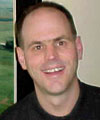
Sunday, 26 Mar 2000
ST PAUL, Minn.
It’s a blast to put a daily diary on the Internet — even for one week. And though it seems that there are no slow weeks anymore, this will be a wild one. At Minnesotans for an Energy-Efficient Economy (ME3), we are teaming up with some of our coalition partners, kicking off our countdown to Earth Day 2000.
This week’s two big items on the radar screen are a Wednesday/Thursday visit from Denis Hayes, chair of Earth Day 2000, and a Thursday/Friday statewide summit of activists, grassroots groups, and other civic organizations ready to join the campaign for Clean Energy Now! Our partners at Clean Water Fund and the Minnesota Project have done a heck of an organizing job, and ME3 has added a few of its own twists that I’ll write about this week.
What I love about working in Minnesota is that folks really work together, make commitments to each other, divide the labor, and play to each others’ strengths. One reason we have almost 1,000 megawatts of new renewable energy on the ground and on the drawing board is that we set a goal in 1993 and kept at it. Now we are launching the next phase, and our long-term goal is to transform our energy economy as thoroughly as the cyber-world has transformed the industrial economy in the past 20 years.
But like anyone with a long “to-do” list, I’ll stick to what can we make happen today and this week. We have a good plan for the week, but I expect surprises.
For example, will our celebrity Minnesota governor, Jesse Ventura, put his head under the hood of a Honda Insight for a photo-op (last week the answer was YES), or will the head of the state pollution agency keep the agency car under wraps, to save its media debut for a speech closer to Earth Day? Will the morning breakfast with Denis, seven U.S. Senate hopefuls, and one U.S. senator (or aide) light up that bulb and help everyone see that it’s time to put clean energy in every stump speech between now and November? Will the media catch on to the countdown idea, or will they put this off until a few days before April 22?
At ME3, we have never before invested much in Earth Day. We weren’t born yet at Earth Day 1990. (Well, I was 35, but our organization wasn’t yet incorporated.) Since that historic sea change of the first Earth Day in 1970, none of us has known how to channel the Earth Day energy into the nuts and bolts of building power and making real and lasting change. We all need to believe that we are truly “part of something really big,” and that a revolution like that of 1970 — which led to the Clean Air Act, the Clean Water Act, the Endangered Species Act, and the creation of the EPA — is ready to happen again.
The theme of Earth Day 2000 — “Clean Energy Now!” and protecting against global climate change — is exactly ME3’s message, and we have centered all our plans on the idea of gaining momentum on Earth Day that we will carry through the end of this year and into the next. Our 25 allies in the Minnesota SEED Campaign (Sustainable Energy for Economic Development) give us enough tools, ideas, and organizers that we can manage an all-out effort. For example, over 80 state legislators have signed our Clean Energy Principles, as have 45 local officials and 45 organizations. This list will build over the next four weeks until Earth Day, and then the issues will carry into the November campaign season, and a supposed 2001 debate on the restructuring of the electric industry.
Today my top objectives are to get a new intern ready to pitch in this week, finalize details of an email Earth Day 2000 PostCard campaign we launch next Monday, and spend some serious time laying out a 2,000-word opinion piece (with graphics) to run in the Minneapolis Star-Tribune the Sunday before Earth Day.
I’ll tell you more tomorrow.
Monday, 27 Mar 2000
ST. PAUL, Minn.
Today we made some final strides toward the launch of a little organizing project that we dreamed up for Earth Day. We want to reach out to young people in rural communities in Minnesota. Environmental groups often make the same mistake over and over again, and defeat their efforts to build a diverse base. They rely on urban elites to make up their membership, and then they wonder why young people, farmers, and regular folks feel ignored.
ME3 decided that for Earth Day 2000 we were going to make a concerted effort to find new voices, including young people and rural people to lend their strength to our effort. We have built a strong coalition with rural economic development officials and local governments and farmers, but we could still broaden our base of support.
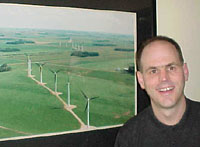
Michael with a really, really big postcard.
We decided to use an Earth Day 2000 PostCard as a clever way to get more people involved. The stunningly beautiful wind farm at right is a real-life snapshot of our vision for a clean energy future, so why not share that vision with others? Over the next month, we hope to get 10,000 citizens to sign up to send free Earth Day 2000 PostCards with a similar image. We’ll send the cards out on Earth Day with a photo taken that morning at sunrise by a professional photographer at the Buffalo Ridge wind farms (no buffalo, just wind turbines and family farms). People can combine a personalized message on the postcard with a request that if the recipient does just one thing this Earth Day, they should sign up to get news and action alerts from us. We have a contract with a web firm in St. Paul that’s handling the design, database, and web marketing for this project.
Using a team of 40 volunteers from 40 campuses, we put up Earth Day Network posters with a tag line inviting people to a special ME3 Earth Day website. On the site, we invite them to send a PostCard to friends or relatives, especially those in small Minnesota towns and suburbs — but we’ll send the cards to anyone, of course. We will also market this PostCard campaign in news stories, radio interviews, chat rooms, and banners on rural Internet service providers.
We have realized over the years that it is not an information gap that slows down clean energy; it is a willingness gap. We hope that thousands of people across Minnesota will get the message about Clean Energy Now! and sign up at our website for regular action alerts to protect our air, our water, and our climate against pollution from fossil fuels. We want to make politicians feel the heat so they will see the light. Groups like Desktop Publishing in Montana have shown us that building a bigger and better database that can quickly get out information is one way to get broader, deeper, and more responsive citizen support.
We know it will take a lot more than 10,000 or even 100,000 Earth Day 2000 PostCards from ME3 friends to change the world. But it’s not a bad start.
Giving credit where its due, Greenpeace gave me this idea (thank you) when they sent me a notice on December 23 for a postcard with a photo of the first light of the new millennium.
Tuesday, 28 Mar 2000
ST. PAUL, Minn.
Did you ever have a day where you did
only urgent things, and kept putting off the most important thing? Today was that day. The urgent things kept coming, and all seemed worthwhile as I did them, but I never started that 2,000-word opinion piece for the Minneapolis Star-Tribune.
I started my day by missing my bus. I love taking the damn bus … am I the only one who does? It picks me up two blocks from my home and 25 minutes later it drops me two blocks from my work. On the bus, I can read, organize my list of tasks, or be obnoxious and use a cell phone.
But this morning I didn’t have the luxury of waiting around for the next bus because I had to be at a wired phone at 9 a.m. for a one-hour live call-in radio show, to be interviewed by a great guy in Falstaff, Ariz. I am part of the Mainstream Media Project’s Earth Day stable of radio interviewees. So I took the call at home, made coffee, and relaxed.
The host warned me that plenty of the listeners would be conservative, because following me was G. Gordon Liddy, of Watergate burglary fame. I love talking about clean energy and global warming to conservatives, though, and it made me think about how my opinion piece for the Tribune for the Sunday before Earth Day has to avoid just preaching to the converted.
Here’s my conservative/populist rap: I’ll practice here, but notice that I wind up ranting. If you have any suggested improvements, email me at noble@me3.org.
Is there anything more conservative than protecting that which you hope to have your children inherit? Aren’t the forests and fisheries, the coastlines and wetlands, and all the animals part of the heritage that you expect to leave to your children and their children? What kind of people would enjoy riches and knowingly leave their children impoverished?
Is there anything more conservative than playing it safe and leaving options open? Isn’t it the radical approach to break with the past and close off options? Why then do people who want to protect the climate from rapid change get painted as radicals, and people who would willingly and permanently alter Earth’s life-support system cloak themselves in the guise of conservatives? Don’t we have that exactly backwards?
Shouldn’t we take stock of a greenhouse atmosphere that we are systematically double-glazing, then triple-glazing, and potentially quadruple-glazing? If for hundreds of thousands of years the carbon dioxide concentrations in the atmosphere did not exceed 280 parts per million, hadn’t we better do some serious conserving and leave open the option to have CO2 stabilize at, say, 450 parts per million? Is 550 ppm (double historical levels) inevitable? Have we lost all sense of our place in creation when we pay our scientists to run models of triple CO2 concentrations, which we could see in just one short century?
(Here comes the populist part:)
The main reason the public is confused about global warming and whether we can tackle the problem is that people are paying good money to keep the public and politicians confused. It’s exactly the same issue that carried forward two politicians who made big splashes this year and last — Jesse Ventura and John McCain. They both ran against the incredible power of money in politics. Is there any organized economic interest on the planet more powerful than fossil fuels?Well, I only said half that stuff before G. Gordon Liddy bumped me off the air in Falstaff, and I’ll have to tone it down for the hallowed opinion pages of the Star-Tribune as well. But I’m telling you folks here at Grist Magazine that Ross Gelbspan is exactly right when he tells us we need a solution on the scale of the Manhattan Project (The Heat Is On, 1997).
All day long I dealt with urgent details related to Denis Hayes’s upcoming visit. (We’ll see Jesse Ventura, but the state pollution agency will keep their Honda Insight under wraps for now. We’ll eat breakfast with all eight U.S. Senate candidates. The Minnesota chair of Earth Day 1970, an iconoclast and great guy who gave me my first job in this field when I was 23, will introduce Denis before his speech.)
In between all that, I had a lengthy discussion with a Carleton College Environmental Studies program staffer about how to frame a speech I’ll be giving on the campus on April 17. She wanted some edge and some reference to big change, but a speech that’s thoughtful and not melodramatic. We both want a big draw, and she was concerned that students’ eyes would glaze over if we concentrate on global change because the problem is too big.
We settled on “Strategic Organizing to Combat Global Warming: Accelerating the Transition to the Solar Economy.”
Help me if you have a better title that you think will draw more college students. We need the next generation. The old farts have largely failed.
Wednesday, 29 Mar 2000
ST. PAUL, Minn.
There are thousands of organizations affiliated with Earth Day 2000 around the world, but I dare any one of them to say that they had more fun today than ME3. Along with our allies, we had 12 hours today with the chair of Earth Day 2000, Denis Hayes. (If you don’t know him, learn a little about him here.)
Several folks pitched in to make a very smooth and high-powered schedule for Denis’s visit, but Minnesota Project’s Lola Schoenrich, the lead organizer on the Sustainable Energy for Economic Development (SEED) Campaign, put it all together.
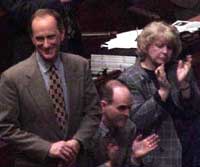
Denis on the House floor (with me applauding in the background).
After making a flurry of media calls to kick off our Earth Day Countdown, our first appointment was with the politician in America with the most sizzle, Minnesota Gov. Jesse Ventura. Without giving a blow by blow, I’ll just say that Jesse and Denis clicked, and some good things could come of it.
Denis was introduced on the floor of the Minnesota House of Representatives by House Environment Committee Chair Dennis Ozment, and I got to accompany Denis there. In 12 years of advocacy in Minnesota, I had never before been on the House floor. At noon, the Senate majority leader hosted a reception and Denis spoke for half an hour, then fielded the questions of at least 15 key state senators from both parties.
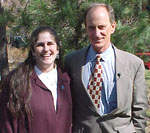
Diana McKeown and Denis.
A public television interview, editorial board visits, and an address to county commissioners on electricity deregulation and the environment rounded out his nine-to-five schedule. For public TV and the editorial board, we teamed him up with Clean Water Action’s Energy Program Director Diana McKeown, the Earth Day 2000 chair in Minnesota.
Tomorrow we start at 7 a.m. After a breakfast briefing with eight politicians from three parties who want to be elected U.S. senator in November, we will do a photo shoot and a talk at a solar-powered school in downtown Minneapolis (the other twin). Then we’ll look under the hood of a Honda Insight for the TV cameras, meet another big editorial board, and do a keynote talk at the Second Bi-annual Energy Summit for organizers and grassroots groups.
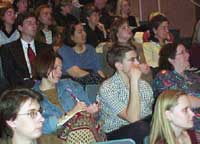
A rapt crowd at Hamline.
For me, the highlight of a whole day that was high was a very thoughtful and detailed speech Denis gave tonight on campus at St. Paul’s Hamline Universtiy. Talking to
a mix of true believers, new faces, and students, Denis spoke with a compelling grace and an encyclopedic knowledge of the issues.
Denis was eloquently introduced before his speech by Tom Griffin, a 60-year-old clean-energy entrepreneur and founder of two key Twin Cities environmental NGOs with 20-year track records. A (paraphrased) excerpt from Griffin’s intro:
I hope that in this meeting tonight sits the next Rachel Carson [author of Silent Spring, the early 1960s book that resulted in the banning of DDT and helped save the bald eagle from extinction] or Theo Colburn [the pharmacist-turned-zoologist who put together the scary pieces of a puzzle of mutation and endocrine disruption in her late 1990s book Our Stolen Future]. No one is standing around ready to pass you a torch. Like in 1970 when Denis made a habit of seizing and occupying college buildings, young people must seize the torch (and the microphone!), and lead.
Thursday, 30 Mar 2000
ST. PAUL, Minn.
Four great events today couldn’t have been more different:
- In a private breakfast with U.S. Senate candidates from three parties, I was the bad cop and Denis Hayes was the good cop. Like citizens in general, environmental leaders are exasperated with politicians who follow instead of lead. Denis predicted that one day, no one knows when, a news event will occur that will snap the issue of global warming into focus — spurring a media feeding frenzy on the order of Elian or JonBenet — and politicians on the wrong side of the issue will be swept into history.
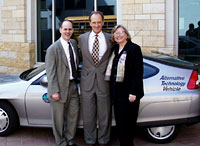
Denis, Dee Long, and I pose in front of a Honda Insight.
We are rocking!


